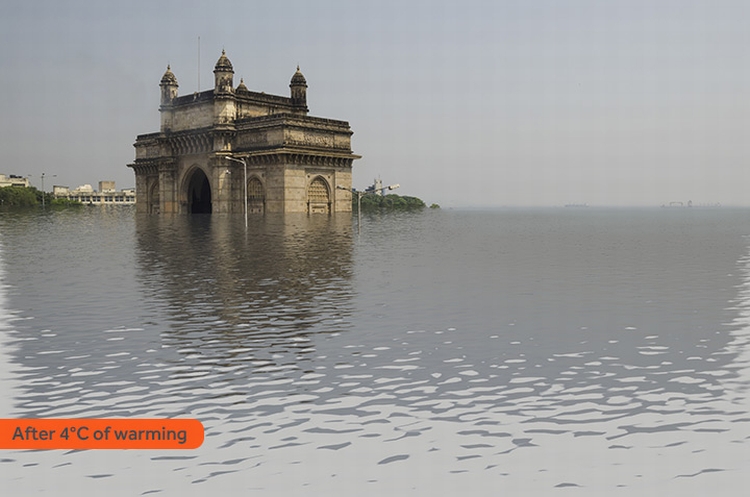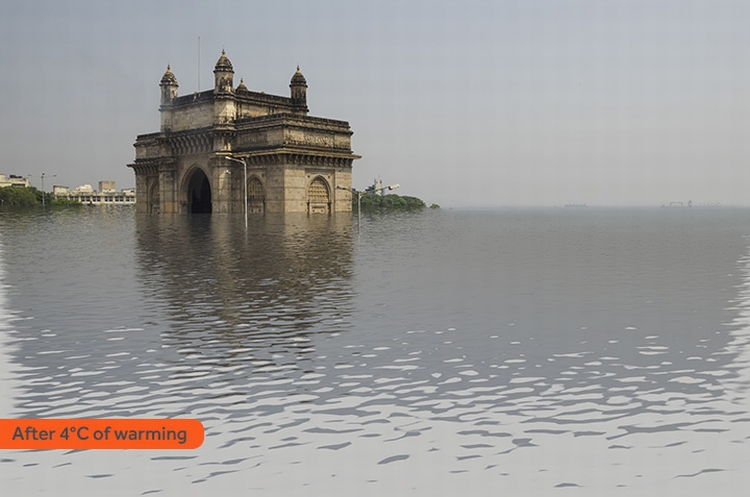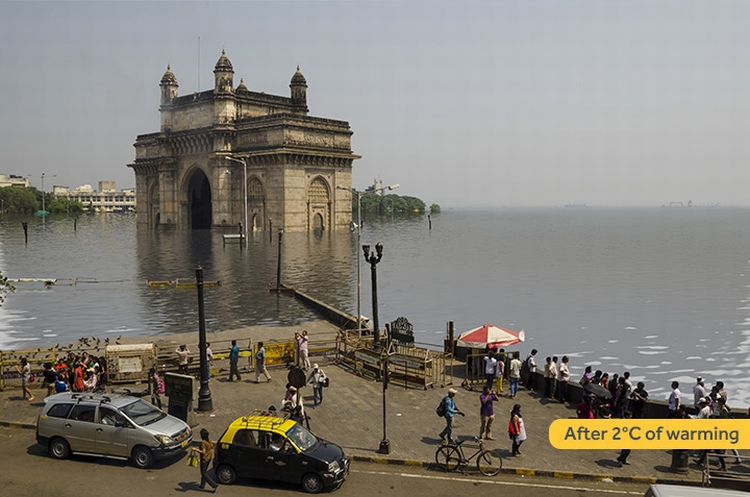Rise in sea levels could displace 55 million Indians living in coastal areas: Report

Recently, a new report published in Climate Central, a US-based non-profit research and journalism organization, nearly 55 million people living in India’s coastal areas are at risk of drowning due to rise in sea levels. The report compared two scenarios – consequences of 2 degree Celsius and that of 4 degree Celsius. In case of 4 degree Celsius rise in global temperature, 55 million people in India’s coastal areas are at risk, while in case of 2 degree Celsius rise, home to 20 million people in India would be submerged in sea.
Paired images released by the Climate Central shows how much region of iconic cities around the world would be submerged in above mentioned two scenarios. Take a look at images of Mumbai:

Image shows Mumbai after post-2100 sea level rise that could be locked in following 4°C (7.2°F) of warming from carbon pollution in the coming decades.

Second image shows Mumbai after post-2100 sea level rise that could be locked in following 2°C of warming
These findings are released just weeks ahead of a UN climate summit in Paris from November 30 to December 11. India is under immense pressure from global community for it rising carbon emissions. India’s coal consumption is set rise beyond record levels. ‘Make In India’ campaign and urbanization is creating more demand for energy. India’s present capacity for solar energy stands only at 4-5 GW.
Similarly, total renewable energy generation capacity makes only a trivial part of total energy generation in India. So, India is highly dependent on coal and fossil fuels to fulfill its energy requirements. According to a recent analysis by the free market Institute for Energy Research,
“India, with the fifth highest coal reserves in the world, is opening a coal mine a month and expects to surpass the United States in coal production by 2020.”
Indian government also admits that it’s not possible to cut down coal production.
“Environment is non-negotiable but we can’t live without coal. You can’t wish away coal. There is a temporary drop in demand, but no question of reducing coal output. We are well short of coal required in the country,” said Anil Swarup, India’s top coal official.
Energy experts claim that emissions will eventually rise despite the fact that countries are now gathering for the Paris climate talk to pledge to cut greenhouse gas emissions. With one –third growth in overall energy consumption through 2040, nations will be forced to use coal and other fossil fuels.
However, India has become the point of focus as it houses 1.3 billion people, out of which about 300 million people still do not have access to electricity. As per the International Energy Agency (IEA),
“We think India is moving to the center stage of global energy. All the numbers are indicating that India will be the number one country in terms of coal consumption worldwide. India will be the number one country for the oil demand growth worldwide. And India will be the country with more than 20 percent of the solar PV worldwide.”
Moreover, an estimated 840 million people are still dependent on the traditional use of solid biomass for cooking. India’s development agenda is in conflict with its rising need of electricity and emissions.
Under global pressure to submit its Intended Nationally Determined Contribution outlined for the Paris climate talks, India has submitted a detailed one. According to India’s INDC, by 2030, India plans to generate 40% of its power capacity from non-fossil fuel sources, to pull 2.5 to 3 gigatons of carbon dioxide out of air, and to cut its emissions by 33 to 35%. However, India has failed to declare a peak for its growing emissions.
The bad news is that even if increase in global temperature is, somehow, managed to 2 degrees, some parts of coastal areas would still submerge in water. In India, the count is estimated to be around 20 million people, while the number is way high for China at 64 million people.
Two Indian cities, Mumbai and Kolkata are among the top 10 megacities across the world that face a serious threat due to rising sea levels owing to climate change.
At a 4 degrees temperature rise, China wouldl be hardest hit with 145 million people at risk. China will be followed by other nations including India, Bangladesh, Vietnam, and Indonesia. Outside Asia, the United States is most threatened with nearly 25 million people at risk.
Globally, 4 degree Celsius warming could submerge area housing 750 to 760 million people, while at 2 degree Celsius, the number could drop to 130 million. More or less, people are going to be hit by rise in sea level. World needs a miracle to avert climate change.


